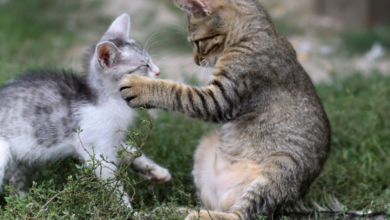7 Common Grooming Challenges For Cats and Possible Solutions

Grooming can be a challenging experience for both cats and their owners. Cats may resist grooming for various reasons, such as fear, discomfort, or simply a lack of familiarity with the process. Here are common grooming challenges and some solutions for stress-free grooming sessions:
1. Resistance to Handling
Resistance to handling in cats refers to their reluctance or discomfort when being touched, held, or groomed. Cats are sensitive to touch and may resist handling due to fear, past negative experiences, or simply because they are not accustomed to it.
Here’s how to overcome the challenge of resistance to handling:
- 1. Gradual Desensitization:
Meaning: Introduce touch gradually and in small steps to desensitize your cat to handling.
Solution: Begin with gentle touches in areas your cat is comfortable with, like their head or back. Gradually extend to less familiar areas as your cat becomes more at ease.
- 2. Positive Reinforcement
Meaning: Use rewards to create positive associations with handling.
-Solution: Offer treats, praise, or playtime during and after handling sessions. This helps your cat associate handling with enjoyable experiences.
- 3. Short and Positive Sessions
Meaning: Keep handling sessions short and positive to avoid overwhelming your cat.
Solution: Start with brief sessions and gradually increase the duration as your cat becomes more tolerant. Always end on a positive note with rewards.
- 4. Cat-Friendly Tools:
Meaning: Choose grooming tools and supplies designed for cats to ensure comfort.
Solution: Use soft brushes, gentle combs, and cat-friendly nail clippers. Familiarize your cat with these tools gradually and associate them with positive experiences.
- 5. Familiarizing with Tools
Meaning: Allow your cat to become accustomed to grooming tools.
Solution: Let your cat sniff and explore grooming tools before use. Reward them for calm behavior during the introduction.
- 6. Handling Feet and Paws
Meaning: Help your cat get used to having their paws handled.
Solution: Gently touch and massage their paws regularly. Gradually introduce nail trimming, rewarding your cat for cooperation.
- 7. Calm Environment
Meaning: Provide a quiet and calm setting for grooming.
Solution: Minimize distractions, choose a comfortable grooming location, and maintain a relaxed atmosphere to help your cat feel more at ease.
- 8. Regular Routine
Meaning: Establish a consistent grooming routine.
Solution: Make handling a regular and predictable part of your cat’s routine. This helps reduce anxiety by making the experience familiar.
- 9. Seek Professional Help
Meaning: Consider professional grooming assistance.
Solution: If handling challenges persist, seek help from a professional groomer experienced in working with cats. They can provide guidance and make the process less stressful.
- 10. Patience and Understanding:
Meaning: Be patient and understanding of your cat’s comfort level.
Solution: Respect your cat’s boundaries, and if they show signs of distress, pause the session and try again later. Patience and a gentle approach are key.
By taking gradual steps, using positive reinforcement, and being patient, you can help your cat overcome resistance to handling and create a positive grooming experience.
Summary on challenge of resistance to handling
Challenge: Some cats may not be accustomed to being handled, making grooming difficult.
Solution: Gradually introduce gentle handling. Start by petting and touching different parts of your cat’s body. Use positive reinforcement, such as treats or praise, to create a positive association with handling.
2. Fear of Grooming Tools
“Fear of grooming tools” in cats refers to a reluctance or anxiety that cats may exhibit when faced with the sight or use of grooming tools such as brushes, combs, or nail clippers. Cats may associate these tools with discomfort, fear, or previous negative experiences, making grooming sessions challenging for both the cat and the owner.
Overcoming the Fear of Grooming Tools:
- 1. Gradual Introduction:
This means you should Introduce grooming tools slowly and allow your cat to become familiar with them.
Possible solution: Let your cat sniff and explore the tools without using them initially. Pair this with positive experiences, such as treats or playtime.
- 2. Positive Reinforcement:
Meaning: Associate grooming tools with positive rewards to create a positive association.
Possible solution: Offer treats, praise, or small rewards while gradually introducing grooming tools. Reward your cat for calm behavior during and after the tool interaction.
- 3. Desensitization:
Meaning: Gradually decrease the sensitivity of your cat to the grooming tools.
Possible solution: Start by lightly touching your cat with the tools, focusing on less sensitive areas like the back. Gradually progress to areas like paws or face, always rewarding positive responses.
- 4. Short Sessions
Meaning: Keep grooming sessions short to prevent overwhelming your cat.
Possible solution: Begin with brief sessions, gradually extending the time as your cat becomes more comfortable. Always end on a positive note with rewards.
- 5. Use Cat-Friendly Tools:
Meaning: Choose grooming tools designed for cats to ensure comfort.
Possible solution: Use soft brushes, gentle combs, and cat-friendly nail clippers. Opt for tools with ergonomic designs to enhance ease of use.
- 6. Professional Grooming Assistance:
Meaning: Seek professional help from experienced groomers.
Possible solution: If your cat’s fear persists, consider seeking assistance from a professional groomer who specializes in working with cats. They can provide guidance and expertise in a controlled environment.
- 7. Regular Handling and Touching
Meaning: Figure out a way to get your cat accustomed to being handled.
Possible solution: Regularly touch and handle different parts of your cat’s body, including areas that require grooming. This helps your cat become more accepting of touch in general.
- 8. Create a Calm Environment
This means you should ensure grooming takes place in a calm and quiet environment.
Possible solution: Minimize loud noises and distractions. Choose a comfortable location for grooming to help your cat feel more at ease.
By employing these strategies and being patient and consistent, you can help your cat overcome the fear of grooming tools and make grooming sessions more positive and stress-free.
Summary on challenge of Fear of Grooming Tools
Main Challenge: Cats may be scared of grooming tools like brushes or nail clippers.
Solution: Introduce the tools gradually, allowing your cat to sniff and explore them. Use treats and positive reinforcement to associate the tools with positive experiences. Start with short grooming sessions and gradually increase the duration.
3. Matting and Tangles
“Matting and tangles” in cats refer to the formation of knots and clusters in the cat’s fur. This can occur when loose hairs become entangled and form mats, particularly in long-haired breeds. Matting and tangles can lead to discomfort, skin issues, and difficulty in maintaining the cat’s coat.
How To Overcoming Matting and Tangles
- 1. Regular Brushing:
Meaning: Brush your cat’s fur regularly to prevent the formation of mats.
Solution: Use a suitable brush or comb for your cat’s coat type. Long-haired cats may need daily brushing, while short-haired cats can benefit from regular grooming sessions.
- 2. Start Grooming Early:
Meaning: Get your cat accustomed to grooming from a young age.
Solution: Introduce grooming activities early in your cat’s life to establish a routine. This helps them become more tolerant of the grooming process.
- 3. Use Cat-Friendly Tools:
Meaning: Choose grooming tools designed for cats to avoid causing discomfort.
Solution: Opt for brushes and combs specifically made for cats. These tools are gentle on the cat’s skin and coat while effectively preventing and addressing matting.
- 4. Check Problem Areas:
Meaning: Pay attention to areas prone to matting.
Solution: Regularly check areas such as behind the ears, under the armpits, and around the tail for signs of matting. Address these areas promptly to prevent mats from becoming more severe.
- 5. Mat Splitting:
Meaning: Use a mat splitter for gentle removal of mats.
Solution: If mats are present, use a mat splitter to carefully and gently work through them. This tool helps separate the mat without causing unnecessary discomfort.
- 6. Professional Grooming
Meaning: Seek professional grooming assistance for severe matting.
Solution: If mats are extensive or difficult to manage, consider consulting a professional groomer. They can address severe matting while minimizing stress for the cat.
7. Preventive Measures:
Meaning: Take steps to prevent matting.
Solution: Keep your cat’s environment clean to reduce the likelihood of dirt and debris in the coat. Regular grooming, proper nutrition, and maintaining a healthy lifestyle can contribute to a smoother coat.
8. Be Gentle and Patient
Meaning: Handle mats with care to avoid causing pain or stress.
Solution: Approach grooming with patience and gentleness. If your cat becomes distressed, take breaks during the grooming session and provide positive reinforcement.
By incorporating these strategies into your grooming routine, you can effectively prevent and manage matting and tangles in your cat’s fur, ensuring their coat remains healthy and comfortable.
Summary on challenge of Matting and tangles
Challenge: Long-haired cats are prone to matting and tangles, which can be painful to groom.
Solution: Regular brushing helps prevent matting. Use a comb or brush suitable for your cat’s coat type. If mats are already present, try to gently work them out with your fingers or a mat splitter. For severe matting, professional grooming may be necessary.
4. Nail Trimming Challenges
“Nail trimming challenges” in cats refer to difficulties or resistance encountered by cat owners when attempting to trim their cat’s nails. Cats may resist nail trimming due to fear, discomfort, or a lack of familiarity with the process. Overcoming these challenges is important for the cat’s well-being and the prevention of potential issues related to long or sharp nails.
Overcoming Nail Trimming Challenges:
1. Positive Association:
Meaning: Create positive associations with nail trimming.
Solution: Offer treats, praise, or playtime before, during, and after nail trimming sessions to make the experience more enjoyable for your cat.
2. Gradual Introduction:
Meaning: Introduce nail trimming gradually to acclimate your cat to the process.
Solution: Start by touching and handling your cat’s paws without attempting to trim the nails. Gradually progress to holding the paws, then to using the nail clippers. Be patient and progress at your cat’s comfort level.
3. Use Cat-Friendly Nail Clippers:
Meaning: Choose nail clippers specifically designed for cats.
Solution: Cat-friendly nail clippers are designed to be gentle and less intimidating. Use scissor-type or guillotine-type clippers, and avoid using human nail clippers, as they may cause discomfort.
4. Regular Handling of Paws:
Meaning: Get your cat used to having their paws handled.
– **Solution:** Regularly touch and massage your cat’s paws when they are relaxed. This helps desensitize them to paw handling and makes nail trimming less stressful.
5. Trimming During Relaxation:
Meaning: Trim your cat’s nails when they are relaxed.
Solution: Choose a time when your cat is calm, perhaps after a meal or a play session. This increases the likelihood of a cooperative and less stressed cat during the trimming process.
6. Short Sessions:
Meaning: Keep nail trimming sessions short to avoid stress.
Solution: Start with a few nails at a time, and gradually increase the number of nails trimmed during each session. Ending on a positive note with rewards helps create a positive association.
7. Seek Professional Help:
Meaning: If challenges persist, consider seeking professional help.
Solution: Consult a professional groomer or your veterinarian for guidance. They can provide tips and may offer assistance in nail trimming, especially if your cat remains highly resistant.
8. Be Calm and Patient:
Meaning: Approach nail trimming with calmness and patience.
Solution: If your cat becomes anxious or resistant, remain calm. Take breaks during the session, and avoid forcing the process. Consistent, patient, and gentle handling helps build trust.
By addressing nail trimming challenges with a positive and gradual approach, you can make the experience less stressful for your cat and more manageable for both you and your feline friend.
Summary On Nail Trimming Challenges:
Challenge: Cats may resist having their nails trimmed, leading to scratching issues.
Solution: Start by getting your cat comfortable with having their paws touched. Use a cat-friendly nail clipper and trim one or two nails at a time. Provide treats and positive reinforcement after each successful session. If unsure, seek guidance from your veterinarian or a professional groomer.
5. Sensitivity to Bathing
“Sensitivity to bathing” in cats refers to the reluctance, anxiety, or stress that some cats may exhibit when faced with the prospect of being bathed. Many cats are naturally averse to water, and bathing can be a challenging experience for both the cat and the owner.
Overcoming Sensitivity to Bathing:
1. Gradual Introduction:
Meaning: Introduce your cat to the concept of bathing gradually.
Solution: Start by allowing your cat to explore an empty bathtub or sink without water. Gradually introduce small amounts of water, rewarding positive behavior with treats or praise.
2. Use Cat-Friendly Shampoo:
Meaning: Choose a mild and cat-friendly shampoo.
Solution: Select a shampoo specifically designed for cats, as their skin is more sensitive than that of humans or dogs. Avoid using harsh chemicals or strong scents.
3. Positive Reinforcement:
Meaning: Associate bathing with positive experiences.
Solution: Offer treats, praise, or playtime before, during, and after the bathing session. Creating positive associations can help your cat feel more comfortable with the process.
4. Short and Infrequent Baths:
Meaning: Keep baths short and infrequent.
Solution: Limit the duration of baths to minimize stress for your cat. Only bathe your cat when necessary, such as when they’ve gotten into something sticky or dirty.
5. Prevent Slips:
Meaning: Ensure a non-slip surface in the bathing area.
Solution: Place a towel or non-slip mat in the bathtub or sink to prevent your cat from slipping, which can contribute to their anxiety.
6. Gentle Handling:
Meaning: Handle your cat gently during the bath.
Solution: Be calm and gentle while bathing your cat. Speak in soothing tones and avoid sudden movements to help keep your cat at ease.
7. Warm Water:
Meaning: Use comfortably warm water for the bath.
Solution: Test the water temperature before bathing to ensure it is lukewarm. Cats are more likely to tolerate baths with water that is neither too hot nor too cold.
8. Towel Drying:
Meaning: Use a gentle towel to dry your cat.
Solution: Pat your cat dry with a soft towel after the bath. Avoid using a hairdryer, as the noise and airflow can be stressful for cats.
9. Consult a Professional:
Meaning: Seek professional grooming help if needed.
Solution: If your cat’s sensitivity to bathing persists, consider consulting a professional groomer experienced in working with cats. They can provide guidance and may handle bathing more efficiently.
10. Regular Brushing:
Meaning: Maintain a regular grooming routine.
Solution: Regularly brush your cat to reduce the need for baths. Brushing helps remove loose hair, dirt, and debris, keeping the coat in good condition between baths.
By approaching bathing with patience, positive reinforcement, and a gentle touch, you can help your cat become more comfortable with the process over time. Always prioritize your cat’s well-being and monitor their stress levels during and after bathing.
Summary On Sensitivity to Bathing:
Challenge: Many cats dislike water and may resist bathing.
Solution: If your cat needs a bath, use a cat-friendly shampoo and introduce them to water gradually. Use a non-slip mat in the sink or tub. Keep the water level shallow, and use treats and praise to reward calm behavior. Consider using waterless cat shampoos for spot cleaning.
6. Aggressive Behavior
“Aggressive behavior” in cats during grooming refers to actions such as biting, scratching, hissing, or growling that can make the grooming process challenging and potentially dangerous for both the cat and the owner. Aggression during grooming can be triggered by fear, discomfort, or a negative association with the grooming process.
Overcoming Aggressive Behavior During Grooming:
1. Slow Introduction:
Meaning: Introduce grooming gradually to desensitize your cat.
Solution: Start by getting your cat used to being touched and handled in non-threatening ways. Gradually introduce grooming tools and activities, rewarding positive behavior with treats or praise.
2. Positive Reinforcement:
Meaning: Use rewards to create positive associations with grooming.
Solution: Offer treats, praise, or playtime during and after grooming sessions. This helps your cat associate grooming with enjoyable experiences and reduces the likelihood of aggression.
3. Short and Positive Sessions:
Meaning: Keep grooming sessions short and positive.
Solution: Start with brief sessions and gradually increase the duration as your cat becomes more comfortable. Always end on a positive note with rewards to reinforce good behavior.
4. Handle Paws and Body Gently:
Meaning: Get your cat used to having specific areas handled.
Solution: Gently touch and massage your cat’s paws, ears, and body when they are relaxed. Gradual desensitization to being touched in these areas can reduce aggression during grooming.
5. Use Cat-Friendly Tools:
Meaning: Choose grooming tools designed for cats to minimize discomfort.
Solution: Opt for soft brushes, gentle combs, and cat-friendly nail clippers. The right tools can make the grooming process more comfortable for your cat.
6. Professional Grooming Assistance:
Meaning: Seek professional help if aggression persists.
Solution: If your cat’s aggression during grooming remains a challenge, consider seeking assistance from a professional groomer or a veterinarian experienced in handling behavioral issues. They can provide guidance and support.
7. Calm Environment:
Meaning: Provide a calm and quiet grooming environment.
Solution: Minimize loud noises and distractions during grooming. Choose a quiet space where your cat feels secure to help reduce stress and aggression.
8. Recognize Warning Signs:
Meaning: Be aware of your cat’s body language and signals.
Solution: Learn to recognize signs of stress or discomfort in your cat, such as flattened ears, dilated pupils, or growling. If your cat shows signs of aggression, give them a break and try again later.
9. Use Towels or Blankets:
Meaning: Wrap your cat in a towel or blanket for restraint.
Solution: Some cats may benefit from being gently wrapped in a towel or blanket during grooming. This can provide a sense of security and reduce the likelihood of aggressive behavior.
10. Stay Calm and Patient:
Meaning: Approach grooming with calmness and patience.
Solution: If your cat becomes aggressive, remain calm and avoid responding with frustration. Patience and a gentle approach can help diffuse tension and build trust.
Overcoming aggressive behavior during grooming requires a gradual and positive approach, along with patience and understanding. It’s important to prioritize your cat’s comfort and well-being to ensure a positive grooming experience for both you and your feline friend.
Summary on Aggressive Behavior During Grooming:
Challenge: Some cats may become aggressive or defensive during grooming.
Solution: If your cat displays aggressive behavior, consult with a veterinarian or professional cat behaviorist for guidance. They can help address underlying issues and provide strategies to make grooming less stressful.
7. Unfamiliar Environments
“Unfamiliar environments” in the context of grooming challenges for cat owners refers to situations where cats are groomed in locations or settings that are not familiar to them. Cats are creatures of habit and may feel stressed or anxious when placed in new or unfamiliar grooming environments.
Overcoming Challenges of Grooming in Unfamiliar Environments:
1. Gradual Introduction to New Spaces:
Meaning: Familiarize your cat with new grooming spaces slowly.
Solution: Allow your cat to explore and get comfortable with the new environment before starting the grooming session. Bring familiar items, such as your cat’s bed or toys, to create a sense of familiarity.
2. Positive Associations:
Meaning: Create positive associations with the new environment.
Solution: Use treats, praise, or playtime to associate positive experiences with the unfamiliar grooming space. This helps your cat feel more at ease and reduces stress.
3. Familiar Grooming Tools:
Meaning: Use grooming tools familiar to your cat.
Solution: Bring the same grooming tools your cat is accustomed to in their familiar grooming space. This can provide a sense of continuity and reduce anxiety.
4. Gentle Handling:
Meaning: Handle your cat gently in the new environment.
Solution: Be calm and gentle when handling your cat. Use slow and deliberate movements to avoid startling or stressing your cat in the unfamiliar setting.
5. Use Familiar Scents:
Meaning: Introduce familiar scents to the new environment.
Solution: Bring items with your cat’s scent, such as a blanket or bedding, to the new grooming space. Familiar scents can help your cat feel more secure.
6. Consistent Routine:
Meaning: Maintain a consistent grooming routine.
Solution: Stick to a similar grooming routine, even in unfamiliar environments. Consistency can help your cat feel more in control and less stressed.
7. Calming Pheromones:
Meaning: Consider using calming pheromone products.
Solution: Use synthetic feline facial pheromone sprays or diffusers in the new grooming space. These products can have a calming effect on some cats.
8. Use Treats and Positive Reinforcement:
Meaning: Reward positive behavior in the new environment.
Solution: Offer treats, praise, or rewards during and after grooming sessions in the unfamiliar space. Positive reinforcement can help your cat associate the new environment with positive experiences.
9. Limit Distractions:
Meaning: Minimize distractions in the new grooming area.
Solution: Choose a quiet and calm space for grooming to reduce potential stressors. Minimize loud noises and disturbances that could contribute to anxiety.
10. Be Patient:
Meaning: Allow your cat time to acclimate to the new environment.
Solution: Be patient and understanding as your cat adjusts to grooming in an unfamiliar setting. Rushing the process may increase stress.
By incorporating these strategies, you can help your cat adapt to and feel more comfortable in unfamiliar grooming environments, promoting a positive and stress-free grooming experience.
summary on Unfamiliar environments
Challenge: Grooming in an unfamiliar environment, such as a grooming salon, can be stressful for cats.
Solution: If professional grooming is necessary, choose a cat-friendly grooming service or ask your veterinarian for recommendations. Create a calm and familiar environment at home for routine grooming sessions.
Remember, patience and positive reinforcement are key to successful grooming sessions. It’s crucial to go at your cat’s pace and make the experience as positive as possible. If you encounter significant challenges or if your cat is extremely stressed, consult with your veterinarian for additional support and guidance.




